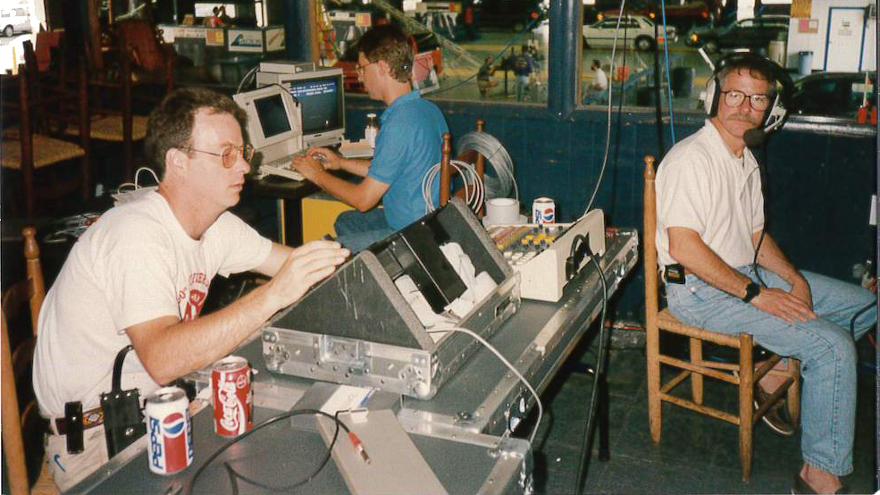SPECIAL PREVIEW: 40 years of milestones, family leadership for State Line

File photo of The 1995 debut simulcast sale at State Line Auto Auction. Image courtesy of ServNet.
Editor's Note: This is a special online preview, available only to CMG Premium subscribers, of Auto Remarketing's upcoming special print edition for the NAAA Convention.
Harry Barber owned a building 40 years ago that his daughter, Jane, used as an indoor horse-riding arena. As Jane grew up and eventually stopped using the arena, Barber wondered what to do with the building.
A family friend asked him, “You ever think about an auto auction?”
The friend took him to an auction in Albany, N.Y., and Barber thought, “I can do that.”
That is how Harry’s son, Jeff Barber, tells the story of the beginnings of State Line Auto Auction. Harry and his wife, Zora, started State Line Auto Auction in 1981. After Zora and Harry died in 1983 and 1984, respectively, ownership passed to Jeff, his sister Jane and brother Dale. Jeff became sole owner in 1994.
But it all started with Harry Barber and the indoor arena in 1981.
“My dad was an entrepreneur with a capital E,” Jeff Barber said. “He was a very successful businessman on the side, although he worked a full-time job for over 30 years at IBM. So, this was one of his startups, and he was 59 years old when he started this auction.”
Milestones add up through the years
The company experienced various milestones in the 40 years after that, including what is said to be the first simulcast auto auction in 1995. Additional milestones included selling what was the last Oldsmobile ever built — a 2004 Alero from the General Motors Heritage Center — and the construction of an on-site rail spur to transport vehicles.
The first milestone occurred in 1981 as the auction started out, and Jeff Barber and his immediate family have owned the business ever since he later purchased the ownership from his siblings. He said the company has retained several long-term employees.
Jeff Barber discussed his company’s work in what is said to be the first vehicle sold by simulcast, in which a remote bidder bids simultaneously with a live bidder on the floor. That sale took place on Oct. 12, 1995, and Barber said he and technology developer Steve Campus formed a joint venture using technology that Campus designed for doctors to vote on issues at the same time from different convention hotel ballrooms in different cities. Campus pitched the technology to major auction companies, which declined to use it. He later showed the technology to State Line Auto Auction during a ServNet meeting, and State Line decided to try it.
Barber explained that the internet at that time was not fast enough for bid recording, so the company used a “phone bridge” in Kansas for the audio and a satellite from billionaire businessman Ross Perot’s company, EDS. EDS was in charge of all satellite technology for GM.
“We transmitted the video through a satellite technology, and we transmitted the audio through telephone lines,” Barber said.
He said remote bidders were in GM dealerships throughout the area, and most were bidding from their parts departments that had a satellite dish on the roof. “They never used it, but we hooked them up,” Barber said. “We had our own people on the road that were making sure that these dealers around this area could successfully get the image they needed and bid accordingly.”
Barber continued, “There was a lot of footwork that took place prior to that first auction. There was a whole lot of just hands-on training and getting satellite dishes out and getting them dusted off and getting the cables hooked up so somebody could … capture the image electronically.”
The early ServNet meeting helped make all of that possible, and Barber said his company is the only original charter member of ServNet that is still a member. He described ServNet members as a “tight-knit group of people,” but many auction owners who were around at the time Barber started with the group have since sold their auctions.
“The composition of the membership has changed a great deal, but it is still a very valuable organization in that we can sit and talk among ourselves and discuss the industry with peer operators and peer owners,” Barber said.
Barber went on to say, “When you lose some people like the Brashers, you lose John Luce and Bill Williams at Flint, you lose the Angelicchio family, there are a lot of players that were in ServNet that are no longer there any more. It definitely changes the composition, but I kind of look at it like a professional sporting team. No team stays the same forever. People come and go, and the same thing (is true) with ServNet.”
Being an original charter member of ServNet is just another of the many milestones State Line Auto Auction has seen in its 40-year history, and another took place about 10 to 15 years ago when many gas-producing entities showed a strong interest in fracking and gas well exploration in the area surrounding the auction.
That caused State Line to look into rail capability at its facility, with the vision to load vehicles onto railcars. The company hired the Gold Star Resources consulting group to help organize the project by obtaining rail and destination shuttle rates.
The State Line Auto Auction spur connects to a Norfolk Southern main line, running between Boston and Buffalo.
GM Financial agreed to provide 45 used vehicles for a pilot move on rail. This past June, State Line loaded those 45 vehicles on five fully enclosed auto rack railcars and shipped them by rail to the Norfolk Southern Voltz Auto Facility in Kansas City, Mo. Once unloaded, the vehicles were shuttled to ADESA Kansas City. GM Financial reported that the transit time was as fast as assigning several trucks to do the move, said Jeff Grandstaff, president of Gold Star Resources.
As State Line notes that vehicle inventories are at a historic low, the company has not used the rail spur since that pilot project. But Grandstaff provided some details on the project and rail itself, noting that about 75% to 80% of all new vehicles built use rail at some point to get to their destination. On the used side, not so much, but he explained that some of the rail cars or auto racks are bi-level, and some are tri-level. Bi-level rail cars haul larger vehicles such as SUVs and trucks, while tri-level rail cars haul passenger cars.
Two spurs, or tracks, go into the State Line property, and five rail cars are placed on each track for a total of 10 maximum.
For rail to work well, it needs to haul a larger number of vehicles, and be a longer-distance move, Grandstaff said. “It would be cost-prohibitive to load one vehicle on one rail car and move it out,” he said.
Grandstaff was present during the GM Financial pilot move, and he said it went well.
“The Norfolk Southern Railroad, State Line Auto Auction, myself, Goldstar Resources, we worked as a team to make it happen, and it went off without a hitch,” Grandstaff said.
Family, long-time employees, make it happen
Long-term State Line Auto Auction employees include sales manager Jim Terwilliger and transportation manager Doug Stack, who have been with the company for 37 years apiece. Lot operations manager Durward Schwartzhoff and factory sales manager Steve Olmsted have both been with the company for 32 years; safety manager Tom Hoyt, 31 years; body shop manager Mike Whalen, 26 years; and title manager Patty Covey and commercial accounts manager Neal McEwen, 25 years apiece. Several other employees have been with the company for 10 to 20 years.
Jeff Barber explained that the auction does not employ a general manager or assistant general manager. Jeff Barber is president of the company, and his daughters
Beth and Emily and son Paul are also owners-partners in the business. Another daughter, Kate, is also a partner and is an attorney in Washington, D.C. Beth, Emily and Paul have worked for the company for more than 10 years apiece.
“We’ve got the owners on site every day so …we’re managing owners,” Barber said.
They grew up in the business, Barber went on to say, adding that after they completed their education, they worked elsewhere before coming to work for the family business.
“And for that I’m very grateful,” Barber said. “So, my wife and I enjoy the fact that three out of our four children are here on a day-to-day basis, providing management for this place.”
He said his wife, Jean, along with being the mother of Beth, Emily, Paul and Kate, is very involved with the business from home.
“She has been my single greatest asset in building the business,” Barber said. “And she is responsible for raising our family so successfully.”


